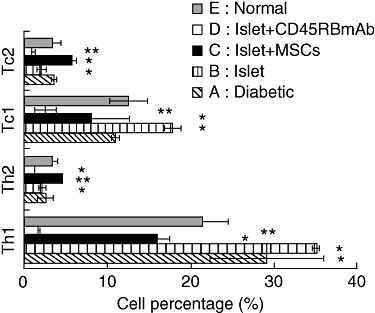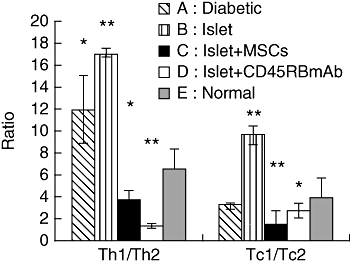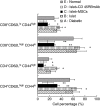Immune modulation of co-transplantation mesenchymal stem cells with islet on T and dendritic cells
- PMID: 20456412
- PMCID: PMC2909419
- DOI: 10.1111/j.1365-2249.2010.04178.x
Immune modulation of co-transplantation mesenchymal stem cells with islet on T and dendritic cells
Abstract
Allogeneic pancreatic islet transplantation theoretically represents a cure for type 1 diabetes. However, current immune suppressive therapies are often associated with undesired side effects. Given this problem, and the shortage of human islet donors, the majority of type 1 diabetes patients cannot currently be offered an islet transplant. However, it has been found that mesenchymal stem cells (MSCs) could exert unique immunosuppressive effects both in vitro and in vivo. Herein we transplanted allogeneic 200 islets alone or in combination with MSCs (3 x 10(6) cells) under the kidney capsules of diabetic C57LB/6 mouse. We found that the ratios of T helper type 1 (Th1) to Th2 and Tc1 to Tc2 were reduced, and the numbers of naive and memory T cells were down-regulated in peripheral blood after transplantation. In addition, the maturation, endocytosis and interleukin-12 secretion of dendritic cell (DCs)-derived bone marrow cells (BMCs) from receptor mice were suppressed. Rejection reaction was alleviated by MSCs which exerted suppressive effects through T lymphocyte subsets and DCs.
Figures






Similar articles
-
[The effect of co-transplantation of bone marrow-derived mesenchymal stem cells and islet on maturation and function of bone marrow-derived dendritic cells in recipient mice].Xi Bao Yu Fen Zi Mian Yi Xue Za Zhi. 2010 Jul;26(7):646-9. Xi Bao Yu Fen Zi Mian Yi Xue Za Zhi. 2010. PMID: 20619087 Chinese.
-
Role of T and dendritic cells in mouse islet allografts treated with anti-CD45RB monoclonal antibodies.Transplant Proc. 2011 Sep;43(7):2721-7. doi: 10.1016/j.transproceed.2011.05.049. Transplant Proc. 2011. PMID: 21911152
-
CTLA4-Ig-modified dendritic cells inhibit lymphocyte-mediated alloimmune responses and prolong the islet graft survival in mice.Transpl Immunol. 2008 Jul;19(3-4):197-201. doi: 10.1016/j.trim.2008.05.005. Epub 2008 Jun 17. Transpl Immunol. 2008. PMID: 18667318
-
Immunomodulation effect of mesenchymal stem cells in islet transplantation.Biomed Pharmacother. 2021 Oct;142:112042. doi: 10.1016/j.biopha.2021.112042. Epub 2021 Aug 14. Biomed Pharmacother. 2021. PMID: 34403963 Review.
-
Utility of co-transplanting mesenchymal stem cells in islet transplantation.World J Gastroenterol. 2011 Dec 21;17(47):5150-5. doi: 10.3748/wjg.v17.i47.5150. World J Gastroenterol. 2011. PMID: 22215938 Free PMC article. Review.
Cited by
-
Mesenchymal stem cells for treating autoimmune dacryoadenitis.Stem Cell Res Ther. 2017 Jun 5;8(1):126. doi: 10.1186/s13287-017-0593-3. Stem Cell Res Ther. 2017. PMID: 28583168 Free PMC article. Review.
-
New therapeutic approaches for type 1 diabetes: Disease-modifying therapies.World J Diabetes. 2022 Oct 15;13(10):835-850. doi: 10.4239/wjd.v13.i10.835. World J Diabetes. 2022. PMID: 36312000 Free PMC article. Review.
-
Mesenchymal stem/stromal cells enhance engraftment, vasculogenic and pro-angiogenic activities of endothelial colony forming cells in immunocompetent hosts.Sci Rep. 2017 Oct 19;7(1):13558. doi: 10.1038/s41598-017-13971-3. Sci Rep. 2017. PMID: 29051567 Free PMC article.
-
iPSC-MSCs Combined with Low-Dose Rapamycin Induced Islet Allograft Tolerance Through Suppressing Th1 and Enhancing Regulatory T-Cell Differentiation.Stem Cells Dev. 2015 Aug 1;24(15):1793-804. doi: 10.1089/scd.2014.0488. Epub 2015 May 18. Stem Cells Dev. 2015. PMID: 25867817 Free PMC article.
-
Mesenchymal Stem Cell-Macrophage Crosstalk and Maintenance of Inflammatory Microenvironment Homeostasis.Front Cell Dev Biol. 2021 Jun 25;9:681171. doi: 10.3389/fcell.2021.681171. eCollection 2021. Front Cell Dev Biol. 2021. PMID: 34249933 Free PMC article. Review.
References
-
- Keating A. How do mesenchymal stromal cells suppress T cells? Cell Stem Cell. 2008;2:106–8. - PubMed
-
- Jones S, Horwood N, Cope A, Dazzi F. The antiproliferative effect of mesenchymal stem cells is a fundamental property shared by all stromal cells. J Immunol. 2007;179:2824–31. - PubMed
-
- Li H, Guo Z, Jiang X, Zhu H, Li X, Mao N. Mesenchymal stem cells alter migratory property of T and dendritic cells to delay the development of murine lethal acute graft-versus-host disease. Stem Cells. 2008;26:2531–41. - PubMed
-
- Peister A, Mellad JA, Larson BL, Hall BM, Gibson LF, Prockop DJ. Adult stem cells from bone marrow (MSCs) isolated from different strains of inbred mice vary in surface epitopes, rates of proliferation, and differentiation potential. Blood. 2004;103:1662–8. - PubMed
Publication types
MeSH terms
Substances
LinkOut - more resources
Full Text Sources
Medical

